You probably know that using a cell phone while driving isn’t trivial at all, but we believe that every driver should read these texting and driving statistics to understand the full consequences of using the phone behind the wheel.
The US has a dangerous epidemic of texting and driving, putting many people on the roads at risk.
That’s why we gathered various valuable statistics that provide complete insight into how dangerous this practice is. While some of the facts may be disturbing, this is still an essential read for anyone who wants to become a safer and more reliable driver.
Quick Texting and Driving Stats – 2024 (Editor’s Pick)
- Texting and driving leads to 11 teenagers dying every day
- A survey showed that 16.2% of drivers texted while driving in 2021
- In 2019, 422 people died in crashes due to cell phone-related distractions
- As per a survey, over 42% of Millennial parents read text messages while driving
- In the United States, 7% of drivers use their cell phones at any given moment
- Texting and driving is as bad as drinking four beers
- Novice drivers can’t use a cell phone while driving in 38 states
- Over 650,000 drivers are using a cell phone while driving at any given moment
Texting and Driving Deaths
1. Around 422 people lost their lives in fatal crashes due to cell phone-related distractions in 2019.
(NHTSA, iii)
Even though much attention has been focused on the risks people take when using a cell phone while driving, the situation is still worrying. In 2019, approximately 387 crashes occurred due to cell phones, with about 390 drivers involved.
Stats on death by cell phones show that somewhere around 1% of the 33,244 fatal accidents and about 13% of all fatal distraction-affected crashes in the United States included cell phone use in 2019.
That’s still substantially below the number of alcohol-related vehicle accident fatalities.
2. Around eleven teenagers die every day because of texting and driving.
(Smile Alive, Burgos Law Firm)
All in all, teenage texting and driving statistics show that young drivers are approximately 400% more likely to be involved in a car accident while texting and driving compared to more experienced drivers.
3. The number of pedestrian deaths rose by 21% from 2019 to 2020.
(NBC News, ITV)
That equated to the largest annual increase in the last 45 years. This can happen when pedestrians talk on their cell phones when crossing the road.
As a matter of fact, a study indicates that pedestrians who are texting while crossing the street are more likely to experience an accident.
4. Almost 390,000 injuries occur annually in texting and driving crashes.
(Automotive Fleet)
Generally speaking, some of the most terrible accidents happen when someone drives distracted. That is to say, using a cell phone while driving leads to about 1.6 million car accidents per year.
Furthermore, distracted driving may lead to many serious injuries. Fortunately, some states are taking steps forward in addressing this dangerous and rising problem.
Adult vs. Teen Texting and Driving Statistics
5. As per a study, a teen using a cell phone has the same reaction time as a 70-year-old who isn’t using a cell phone.
(Heights Libraries)
The data mentioned above was confirmed in a study by the University of Utah. Unsurprisingly, senior drivers are the least likely to use a cell phone while on the road.
In addition, based on texting and driving stats, the minimal amount of attention needed for a driver to text is five seconds — the same as driving past an entire football field without keeping your eyes on the road.
6. In 2019, 39% of high school students who’d used their car in the past 30 days said they texted while driving.
(CDC)
They reported doing so on at least one of those days. As per texting and driving statistics by age, texting or emailing while driving was more frequent in older students.
Moreover, these students also engaged in other dangerous behaviors, like not wearing a seatbelt, riding with a drunk driver, or driving after drinking.
7. While driving, 42.2% of Millennial parents read text messages, according to a survey.
(JAMA Network)
This age group reads text messages while driving more commonly than older parents. In fact, the survey noted that 26.7% of older parents read text messages while behind the wheel.
However, regardless of their age, 67.1% of parents reported using their phones less when they have their children in the car with them.
Cell Phones and Driving Statistics
8. 52% of US survey respondents reported talking on a hand-held phone when driving in the last 30 days.
(All on Georgia)
The same survey found that over four in ten respondents had read an email or text while on the road. Furthermore, more than three in ten respondents had sent an email or text while behind the wheel.
9. According to a survey, 16.2% of drivers texted while behind the wheel in 2021.
(Dordulian Law Group, Drive Safely)
That represented a drop of 2.2% compared to 2020. In addition, in 2020, 29.4% of people were aware of their state’s laws on texting and driving, and texting and driving statistics from 2021 showed that the percentage jumped to 31.6% in 2021.
Almost 60% of respondents thought talking on the phone wasn’t as dangerous as texting when driving.
10. If you use a cell phone while driving, you will spend 400% more time with your eyes off the road.
(HDMJ, Daspit Law Firm)
In addition, when it comes to cell phones and distracted driving stats, texting carries the highest risk of all phone-related activities.
In addition, research indicates that the most dangerous type of distraction while driving is one that takes your hands off the wheel, your eyes off the road, and your mind wandering.
11. 95% of study respondents considered reading or typing on a hand-held phone while driving very or extremely dangerous.
(NCSL)
Then again, around 22.5% of the respondents thought using hands-free technology while driving to be very or extremely dangerous. Moreover, the study also pointed out that 80% of its respondents found talking on a hand-held phone to be very or extremely dangerous.
12. As per texting and driving statistics by state, New Mexico was the state with the highest distracted driving fatality rate in 2019.
(Money Geek)
In general, the state doesn’t ban the use of cell phones for drivers except for new drivers who have their provisional or learner licenses. That said, if they violate this law, they can be stopped by the police, as they would be committing a primary offense.
13. There are 1.6 million car accidents caused by texting each year.
(The Barnes Firm)
This is according to research by the National Safety Council. That’s every fourth accident that happens on US roads. Moreover, over 3,000 of them result in death. As per the same research, texting is more dangerous than talking on the phone when driving.
14. In the US, 7% of drivers use their cell phones at any given moment, which may ultimately lead to cell phone deaths.
(Hull&Zimmerman, Torgenson Law)
Cyclists, pedestrians, and other drivers can experience severe injuries or even lose their lives if they come into contact with a distracted driver. Even though there are many worrying statistics on this issue, only 23 states ban entirely cell phone use while driving.
15. A quarter of the UK drivers make or receive calls while driving.
(Totally Driving)
As per texting and driving statistics worldwide, recently, cell phone while driving has been increasing in the United Kingdom.
People use phones to make calls, check email, text, and use social media while driving in the United Kingdom. Namely, that rate is more than 50% in drivers between the ages of 17 and 24.
16. 76% of study respondents supported hand-held bans.
(NCSL)
Furthermore, 86% supported texting while driving bans. These texting and driving statistics are encouraging, with well above the majority of drivers supporting hefty fines for those using a cell phone while driving.
Be that as it may, 29.3% of the respondents claimed they had typed a text or email, 38.6% had read using a hand-held device, and 43.2% had talked on a hand-held phone while driving at least once in the last 30 days.
Statistics on Texting and Driving vs. Drunk Driving
17. Texting while driving is six times deadlier than driving under the influence of alcohol.
(Stewart Law Offices)
One study found that writing a text message delayed a driver’s reactions by 35%, whereas a driver’s reactions were slowed down by 12% after drinking alcohol to the legal limit. As per another study, when comparing texting and intoxicated drivers, the former react 23% slower.
18. According to texting and driving statistics from 2020, texting and driving is on the rise, while drunk driving is declining.
(Stewart Law Offices)
The NHTSA considers that people underreport texting while driving. Instead of texting while driving, there are still other ways to reply to the message without jeopardizing your life.
If a message is important and you have to respond to it right away, the safest thing to do is pull over the car and then respond. Or, if there’s a passenger in the car with you, you can give your phone to them and ask them to reply for you.
19. Stats on texting and driving confirm that texting while driving is as bad as drinking four beers.
(Davis Law Group)
So, a driver who is texting is as impaired as one who has drunk four alcoholic drinks. Generally speaking, drunk drivers are dangerous since their judgment is impaired, their reactions are slower, and they may not be able to notice some obstacles on the road.
Moreover, according to car accident statistics, around 28 people die daily due to drunk driving.
20. Distracted driving causes 35% more injuries than drunk driving.
(Dordulian Law Group, Aceable)
That’s also contributing to the increasing number of texting while driving deaths. Given that around 30% of Americans don’t drink alcohol, but no one can be immune to distractions, there are more distracted drivers than drunk ones.
Moreover, the state with the highest number of distracted drivers is New Mexico, while Noth Dakota has the highest number of DUIs.
All in all, distracted driving has been increasing due to the distractions technology keeps bringing on.
Dangers of Texting and Driving Statistics
21. Alaska is the state with the most serious penalty for cell phone violations.
(Torgenson Law)
As a matter of fact, the first-time violation fine for texting and driving is somewhere around $500. Then again, if cell phone use causes serious injuries or death, the driver may get a felony conviction and a fine of $250,000.
In addition, the texting and driving per state graph shows that texting and driving is banned in 49 states, while 23 states ban entirely cell phone use while driving. Only Missouri and Montana don’t have laws banning texting for all drivers.
22. In 38 states, novice drivers can’t use a cell phone while driving.
(Torgenson Law)
That includes six states with secondary enforcement and 32 states with primary enforcement.
Since teenage distracted driving statistics show that novice drivers, like teens and young adults, are most at risk of being involved in a fatal crash due to cell phone use, they mustn’t engage in such behavior.
Moreover, studies reveal that restrictions on nighttime driving and the number of teenage passengers have a positive impact, reducing fatal adolescent crashes.
23. 660,000 drivers are using a cell phone while driving at any given moment, often leading to text and drive accidents.
(TDI)
When using phones or other similar devices, drivers can miss seeing about 50% of what’s happening around them, including pedestrians, other drivers, or cyclists. So, if a driver takes their eyes off the road even for a second, they engage in dangerous activity.
24. Points on your driving record can impact your car insurance rates.
(Way)
The majority of car insurance companies will significantly raise your rates if you get a citation for texting and driving. The only way to avoid this is if the violation happens out of state, and your home state doesn’t track out-of-state violations.
Conclusion
We hope that these alarming cell phones and driving statistics will inspire drivers to become more alert. The odds of an American dying in a car crash are 1 in 101, and texting while driving increases them even further.
Having sufficient limits on your car insurance policy is the first thing to check. It’ll provide funds to cover injury expenses and property damage after an accident. Additionally, completing a certified driving course will improve your skills and make you an even safer driver.
Finally, investing in a safe and reliable vehicle will further improve your chances of staying uninjured.
Still, the first step in avoiding becoming a statistic is to avoid texting while driving at all costs. Life is busy, but let’s not forget it’s also precious.
People Also Ask
Every year, many crashes occur due to distractions, especially texting and driving. It’s tough to know the exact number of these fatalities, as not everyone reports they were texting while driving. Roughly, there are around 400 deaths due to this type of distraction per year.
As we can see, the situation is worrying, so almost all the states have taken measures and banned texting while driving.
In 2019, there were 387 crashes because of cell phones, involving 390 drivers. Furthermore, they resulted in around 422 fatalities in the United States, representing 13% of the distraction-affected fatalities.
Moreover, New Mexico was the state with the highest distracted driving fatality rate in 2019. The state doesn’t ban the use of cell phones for drivers apart from new drivers who have their provisional or learner licenses.
The following several statistics are the most crucial and enlightening ones regarding texting and driving:
– Every year, nearly 390,000 injuries happen in crashes due to texting and driving.
– Due to texting and driving, 11 teenagers die per day.
– Over 40% of Millennial parents read text messages while driving.
– A survey showed that around 16% of drivers texted while behind the wheel in 2021.
– Texting and driving statistics reveal there are 1.6 million car accidents due to texting annually.
- Aceable
- All on Georgia
- Automotive Fleet
- Burgos Law Firm
- CDC
- Daspit Law Firm
- Davis Law Group
- Dordulian Law Group
- Dordulian Law Group
- Drive Safely
- HDMJ
- Heights Libraries
- Hull&Zimmerman
- Iii
- ITV
- JAMA Network
- Money Geek
- NBC News
- NCSL
- NHTSA
- NSC
- Smile Alive
- Stewart Law Offices
- TDI
- The Barnes Firm
- Torgenson Law
- Totally Driving
- Way



